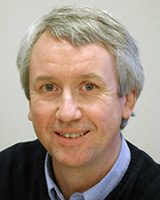Introduction
Approximately one billion people world-wide lack access to adequate amounts of safe water1. Most are in developing countries, especially in rapidly expanding urban fringes, poor rural areas, and Indigenous communities1,2. Municipal water treatment systems can be impractical in these settings. For many of these populations, inexpensive household water treatment is a reasonable alternative3-5.
Over the past 5 years, the Manz BioSand intermittent slow sand filter has been widely-distributed for household water treatment in developing countries around the world. The Manz BioSand filter units are in use in 20 countries around the world, among them Honduras, Mexico, the Dominican Republic, India, Pakistan, Nepal and Uganda. Over 80 000 filters have been installed and it is estimated that 500 000 people are drinking water treated by the BioSand filter. The first filters were installed in Nicaragua in 1996. This article is one of the first to document their use in the reviewed scientific literature. The advantages of BioSand filter are that it can be built locally, it is easy to use and maintain, it does not require electricity, and it is relatively inexpensive.
Previous laboratory studies have shown the BioSand filter to be effective in significantly reducing the number of parasites and bacteria in the source water6,7. However, little data are available from field studies concerning the filter's performance and sustained use over time.
The main objectives of this study are to: (i) gather information about the general hygiene and sanitation in the households using the filter; (ii) record the users' perceptions relating to level of satisfaction with the performance of the filter; (iii) make observations about the durability and sustainability of the filter after prolonged use; (iv) collect data about the filter's efficiency in removing bacteria and reducing turbidity under typical working conditions; and (v) track the levels of Escherichia coli in household water from source to point-of-use.
Methods
Background
The BioSand filter works in much the same way as the large-scale slow sand filtration systems which have been in use in municipal water treatment for over 150 years8,9. The filter cleans the water by a combination of mechanisms. Mechanical trapping is the most obvious and is related to the size of the pore spaces created between the sand granules. Adsorption of suspended materials to the surfaces of the sand granules also plays an important role. In addition, the filter benefits from a biologically active layer, which develops spontaneously in the micro-environment existing near the interface of the sand and water. Organic nutrients from the source water are trapped in the upper 5-10 cm of the sand. Oxygen diffuses through the standing water from the air above to the biolayer, allowing aerobic respiration to occur. The community of organisms which develops in this micro-environment enhances the filter's ability to remove bacteria and parasites6.
The filter was developed during the 1990s by Dr David Manz at the University of Calgary in Alberta, Canada. The design allowed the slow sand filtration process to be used in households because water could be added intermittently rather than depending on continuous flow. This was accomplished by routing the outflow pipe from the bottom of the container up its side to a point 5 cm above the sand. This ensures that that sand remains submerged. The Manz design is illustrated (Fig 1).
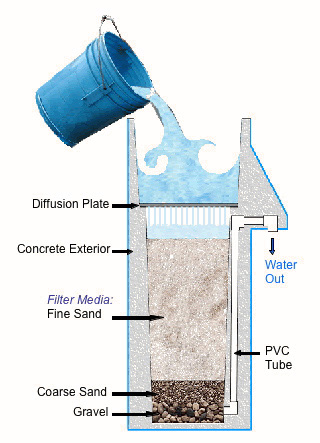
Figure 1: Manz BioSand filter.
The container is made of concrete, stands 95 cm in height and 36 cm in width. It weighs approximately 150 kg empty, and 225 kg filled with the sand and water and ready to use. The flow rate is 30-40 L/h with a maximum of 60 L/h. It can be produced for approximately US$25. The filter is cleaned by stirring the top 5-10 cm of sand, thereby re-suspending the trapped particles in the standing water, which then can be removed with a cup or ladle. This process is repeated until the standing water remains clear or the proper flow rate is restored. Figure 2 is a photograph of a BioSand filter in place in a Haitian home.
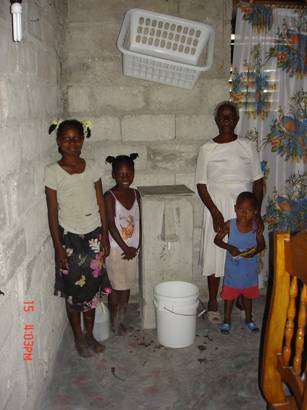
Figure 2: BioSand filter in a Haitian home.
Setting
The Artibonite Valley is a productive agricultural area in central Haiti. Much of the valley floor is irrigated. People commonly have access to water from hand-dug wells near their homes. Some also have access to water piped from deep-bore wells or developed springs to shared stand pipes. Wells in the irrigated valley floor may be only 1.5-2 m deep. But in the hills above the irrigation canals the hand-dug wells are often 5-10 m in depth.
In 1999, Dr Manz visited Hospital Albert Schweitzer in Deschappelle, Haiti to instruct the staff of the Community Development Division in the construction, installation, and maintenance of the Manz BioSand filter. Community Development had received US $65 000 in grants to install filters in households in the communities around Deschappelle. The program called for the householders to pay US $12, or approximately one-third to one-half of the anticipated costs. The staff began installing the filters in late 1999. By 2004, approximately 2000 filters had been distributed in the Artibonite Valley.
Personnel
Eight local people were hired for the study. These included two teams of enumerators, each consisting of a nurse and a filter technician, two lab technicians, a data entry person and a translator. The salaries paid were commensurate with those for a similar job at the Hospital Albert Schweitzer. All information was obtained and recorded in Haitian Creole. Training of the project staff occurred over a 2 week period immediately preceding the onset of the study. The first week was devoted primarily to educational topics, and the second week was spent practicing the interviews, observations, water samplings and laboratory procedures.
Statistical analyses
It was of high importance to the study to have as large a representation from the population as possible but costs were (and usually are) an obvious limitation to this. The 107 households were determined by the investigators as a goal and represent what we felt was a reasonable sample set (5%) of the 2000 filters installed in the area.
Household visits
The households visited were selected in a non-random manner. Many of the filters had been installed by the filter technicians, and the households were chosen from their memory. Others were identified by asking members of the community which households had filters. All the filters had been in use for at least one year. The visits were spread throughout the valley among ten communities within 1-2 h drive from Deschappelle.
Each household was visited at least twice. The first visit was unannounced. The enumerator's presentation at this visit was scripted. The study was explained and the user's consent to participate was obtained at this time. An appointment was then made for the second visit, scheduling 2 h for the interview, observations, and water sampling. Each participant was offered a 20 L plastic water storage bottle as compensation for their time. The primary investigator and the project coordinator accompanied the teams to each of the visits and filled-out duplicate copies of the questionnaires and observations in English. The questionnaire contained a total of 45 questions pertaining to family demographics, water source, filter use, water storage, sanitation, hygiene and health (Appendix I). The observations included 19 separate data points relating to the filter's construction and use, filtered water storage methods, sanitation facilities, and general hygiene. The flow rate of the filter was measured, and analyses to determine the free chlorine level and pH of the stored filtered water were performed at the household.
In 87 households, water was sampled at five locations from the source to the point-of-consumption: the source; the transfer bucket used to carry water from the source; the standing water in the filter; the filter's spout; and the storage container for filtered water. In twenty households, water samples were collected at only four locations, omitting the source water sample because of compromised incubator space.
The samples were collected in standard 250 mL 'Whirl-pak' sample bags (NASCO; Atkinson, WI, USA). The bags were labeled and stored in a cooler until delivered to the laboratory. The sample was refrigerated and analyses performed within 24 h of collection.
Water analysis
A laboratory area in the Community Development building was used during the study to perform the water analyses. It consisted of a work bench with sink, cabinets and refrigerator, and an adjacent office. All the laboratory supplies and equipment needed to perform membrane filtration and turbidity measurements were supplied by the Project BRAVO. Methods for water quality and bacteriology conformed to Standard Methods10. The culture medium was prepared weekly in the lab using Difco's modified mTEC dehydrated agar. The filter apparatus and flasks needed to perform the membrane filtration were glass and were autoclaved using a steam sterilizer. The samples were incubated in a Hach portable incubator. Samples with colony counts above 300 were considered to have too many colonies to be counted accurately; so repeat samples were obtained and diluted serially until a number less than 300 could be counted on the membrane. This occurred in 22% of the households sampled. The membrane filtration laboratory procedures followed the US EPA Standard 1603. Quality assurance was assessed by using sterile water in 10% of the samples as 'blanks', and duplicate samples from 10% of the households visited to assess variation between samples.
Turbidity was measured using the Hach 2100P turbidimeter.
Results
Questionnaires and observations
The questionnaire (Appendix I) was developed by committee, which included UNICEF and WHO personnel. After revision and field testing, it was reduced to what was felt to be a reasonable size, one version in English and one in Creole. The 'test and validation' of the questionnaire was performed by the enumerators practicing the interview questions as part of their training. Also, the questionnaire was trial tested with households as part of the training. Finally, criteria for judging subjective observations were developed and agreed on by the two teams of enumerators, as part of their training.
One hundred and seven households were included in the study. Most of the houses had cement floors and walls, and many also had yards big enough to accommodate a hand-dug well and a latrine. Family size ranged from 1 to 15 persons, averaging 5.4 per household. The households contained a total of 71 children under the age of 6 years. Ten of these children had been sick with diarrhea within the past 2 weeks. Seven of these took 'leaf' medications, which are naturally-occurring herbal remedies. Two were seen in a clinic. None was hospitalized, and all recovered.
Sixty-one percent of the families obtained their water from hand-dug wells. Twenty-six percent had access to piped water from springs or deep wells, and thirteen percent had access to both. The average contamination of the source water samples was 202 E. coli cfu/100 mL. The source was within 50 m of the house in 93% of the cases (range from 3 m to 1 km).
Most families (85%) had latrines in their yards. The enumerators rated these latrines as 'not clean' in 61% of the households. Five percent had toilets in their homes, and 7% had access to neither latrine nor toilet and used the bush or the canals. In 67% of the cases, the latrine was located at least 25 m from the well (range: 10-112 m). There was no garbage removal service, and most families burned their garbage or threw it out in the yard or street. Twenty percent of the families reported that they composted some of their garbage.
All of the families responded that they used soap. However, soap was observed to be present at the primary hand-washing station in only 30% of the households. The over-all hygiene was rated by the enumerators as 'generally good' in only 18% of the households, while 82% were rated as 'poor' or 'very poor' (this rating was based on definitions and parameters taught during the training).
The filters had been in use from 1 to 5 years, averaging 2.5 years. No alteration in performance related to the age was detected, and no filters were encountered that had broken. All of the filters included in the study were functioning at the time of the second visit when the water samples were collected. Four of the filters included in the study were not functioning at the time of the first visit. Three of these filters were blocked and required maintenance. In the fourth case, the filter had been sold and the new owner installed unscreened river sand after the filter was moved. The problems were corrected, and the second visit to these households was scheduled 2 weeks after the remediation. Two households were visited where the filters had been installed but were not being used, in one because of illness and in the other because of a family dispute.
In 91% of the households, the filtered water was used only for drinking. None of the households treated the water with chlorine after filtering. Eighty-five percent poured the source water directly into the filter, not allowing time for sedimentation or settling. One hundred percent of the households reported that they liked their filters, citing better quality water (49%), health protection (22%), and 'because it works well' (7%) as reasons. In 99% of the interviews, the participants answered that the filtered water appeared cleaner, tasted better, and smelled better than the source water. One hundred percent reported that the filter was easy to use, and that the children who were old enough to lift the bucket could use the filter. Ninety-nine percent said that the filter produced enough water for the entire household. Ninety-five percent felt that their family's health had improved since they began using the filter, while 5% had not noticed any change. Ninety-five percent responded that they would recommend the filter to others. Fourteen households reported that they had had problems with slow flow rates and six said that they had to obtain assistance from Community Development to correct the problem. In all of these cases, the problem was blocking of the filter due to accumulate silt and was easily corrected by the 'swirl and dump' procedure.
In 92% of the cases, the filters were found to be well-maintained. The average flow rate for the filters was 35.4 L/h, ranging from 11-95. One of the filters was found to have a crack near the lip of the filter above the spout, but it was still being used and seemed to function well. Containers used to store the filtered water were classified as large-mouth in 37% of the households, small-mouth in 12%, and both were used in 51%. All of the containers were covered in 74% of the households, and in 26% some or none of the containers were covered. Free chlorine measurements substantiated the assertion that the water was not being treated after filtering; pH measurements ranged from 7 to 8.5.
Laboratory
The turbidity in source water ranged from 0.37 to 71.1 NTU, averaging 6.2 NTU. The filtered water samples fell to an average of 0.9 NTU (range: 0.2 - 2.3 NTU).
E. coli counts were higher in the hand-dug well water (average 234, median 53, cfu/100 mL) than in piped water from springs or deep wells (average 195, median 27, cfu/100 mL). The filtered water samples collected at the filter spout contained less than 10 cfu/100 mL in 97% of the filters (80% with 0 cfu/100 mL and 17% with 1-10 cfu/100 mL). In 3% of the samples from the filter spouts, the E. coli counts were greater than 10 cfu/100 mL. The colony counts on these three samples were 12, 15 and 22 cfu/100 mL. Among the source water samples, only 25% were found to be in the 'reasonable' range (0-10 cfu/100 mL), 46% were in the 'polluted' range (11-100 cfu/100 mL), and 28% were in the either the 'dangerous' (100-1000 cfu/100 mL) or 'very dangerous' (>1000 cfu/100 mL) range, according to WHO definitions for water safety11.
E. coli counts were found to be higher in stored filtered water than in the filtered water from the spout. In 22% of the samples from the point-of-use container, the E. coli counts were greater than 10 cfu/100 mL, versus the 3% of the samples taken from the filter spout. Figures 3 and 4 summarize these data. The issue of recontamination of drinking water after treatment has been discussed by previous investigators12,13 and is felt to be a serious issue. Our data showed that contamination was higher in storage containers than when the water existed in the BioSand filter unit.
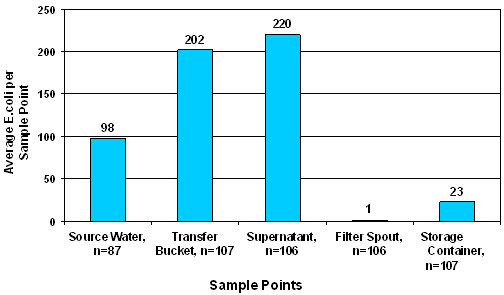
Figure 3: Removal effectiveness and recontamination using E. coli as indicator.
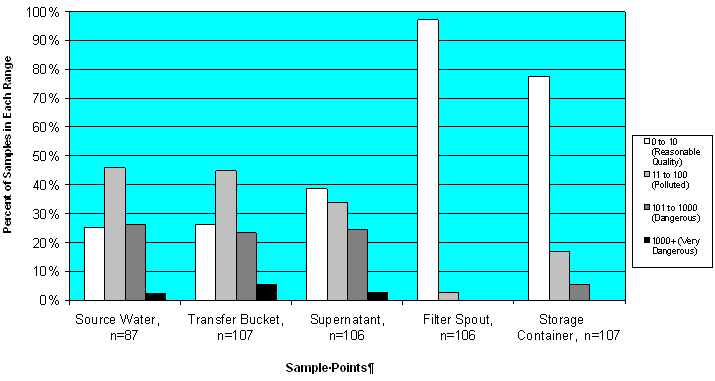
Figure 4: Ranges of E. coli by source sampled.
The E. coli removal efficiency was based on samples taken from the water from the source (E. coli in) versus samples taken from the filter spout (E. coli out). The removal efficiency for each filter was calculated using the following formula: (number E coli in) minus (number E. coli out) divided by (number E. coli in), expressed as a percentage. The average of the removal efficiencies for all the filters was 98.5%. Ninety-two out of the 107 filters were included in this calculation. Ten were omitted because there were zero E. coli in and zero E. coli out, four were omitted because of unusable or unreliable data, and one was omitted because of incomplete data.
Discussion
Household visits
The household visits revealed that the users of the BioSand filters tended to own their homes and their houses tended to be made of cement and have cement floors. Most had access to a latrine in their yards. Their sources of water were contaminated into the polluted or dangerous range in 71% of the cases. The overall hygiene of most of these households was rated as poor. Contamination of water during storage has been previously identified as a problem14.
The questionnaire responses indicating a high degree of user satisfaction is supported by the observations that 92% of the filters appeared to be clean and well-maintained, and that 97% were functioning at the time of the unannounced first visit. The filters were found to be durable with a few having chips along the lip, and only one with a crack that resulted in a leak. This filter continued to be used because the crack was above the resting water level, and the filter leaked only when source water was added. The height of water above sand, the supernatant level, was observed to be within the range of 2.5-7.5 cm in 100% of the filters, implying regular use.
Measurements of the flow rates revealed that the average flow rate for the filters was within normal range. However, 28% of the filters had flow rates below normal, and many of the users indicated that they did not know how to perform the maintenance procedure to restore flow. Shallow wells especially produced water with high turbidity levels due to suspended particles. The filter effectively removed the suspended particles, reducing the average turbidity from 6.2 to 0.9 NTU. The trapping of the suspended particles results in decreased pore size, and thus decreased flow rate. Thirteen percent of the participants reported that they had problems with decreased flow, and 6% reported that they have needed assistance from Community Development to restore normal flow rate. Thirty-six percent of the households reported that they had not been visited by the staff of Community Development since their filter was installed.
Laboratory results
The filters were found to have an average E. coli removal efficiency of 98.5%, and the filters were found to produce water in the safe or reasonable range in 97% of the cases. Still, 20% of the samples from the filter spout were above the WHO limit of zero E. coli/100 mL for 'safe' water.
In this study, recontamination was found to occur in a significant number of households. The number of samples from the storage containers with more than 10 E. coli cfu/100 mL was seven times higher than it was in the samples taken from the spout. The provision of safe drinking water seems to depend as much on good hygiene and cleanliness of water storage containers as it does on water filtration technology
Conclusions
The data support the following conclusions:
- Perceptions of the participants regarding quality of water, ease of use, and quantity of clean water produced indicate high levels of overall satisfaction.
- Observations revealed that the filters were durable, and that most were well-maintained, functioning properly after an average of 2.5 years of use.
- The turbidity measurements showed that the filters functioned well to reduce turbidity.
- The water analyses showed that the filters are effective in removing significant E. coli bacteria.
- A more significant issue than the filter's bacteria removal efficiency may be the incidence of re-contamination.
- Disinfection of the stored filtered water is recommended to ensure that it remains in a safe or reasonable range with respect to bacterial contamination.
- Education about water-borne diseases, methods of safe water storage, and methods of disinfecting the stored filtered water should accompany the installation of the filter.
On the basis of this trial, the Manz BioSand filters are an attractive option for supplying water treatment to family units in rural areas of poorly developed countries. The efficiency of water improvement through reduction of bacterial numbers, coupled with the low cost and low technology of these units was seen to be a significant attribute to reducing the risk of water borne disease and improving general medical health. We would recommend further trials of this technology. We feel that any shortcomings of the BioSand filter are likely best addressed by user education about the operation and maintenance and proper monitoring of the filter media (fine sand) preparation and installation and of fundamental hygiene practices but that the basic principles of the technology are sound.
Acknowledgements
The authors would especially like to thank their Haitian friends who actually performed the study. Enumerators: Joswe Salomon, Mirlene Altidort, Joseph Leonce-Claude, and Mari-Ange Genestine. Lab technicians: Davona Mondesir, Masseline Griseau. And Elisna Sterling, entered all the data into an Excel Worksheet with quiet grace. And to Agenor Bien Aime, who translated the forms and interpreted the language and the culture. The authors would also like to thank the staff of Community Development, Dawn Johnson, Herbe Cleophat, and Renold Estime for sharing their wisdom and their space in providing the lab. Special thanks go to the entire staff at the Center for Affordable Water and Sanitation Technology, a Canadian not-for-profit engineering and training organization, which provided the initiative for this study. Special thanks also to Ron Lentz for his expertise editorial review, to Diana Frost who conducted the training sessions in Creole, sometimes translating into three languages at once, and to Roman Cipus, who was the in-country coordinator for Project BRAVO.
References
1. Bartram J, Lewis K, Lenton R, Wright A. Focusing on improved water and sanitation for health. The Lancet 2005; 365: 810-812.
2. Gundry S, Wright J, Conroy R. A systematic review of the health outcomes related to household water quality in developing countries. Journal of Water and Health 2004; 2(1): 1-13.
3. Sobsey MD. Managing water in the home: accelerated health gains from improved water supply. (WHO/SDE/WSH/02.07). Geneva: World Health Organization, 2002.
4. Prasad V. Low cost domestic water filter: the case for a process-based approach for the development of a rural technology product. Water SA 2002; 28(2): 139-148.
5. Clasen T, Cairncross S. Household water treatment: refining the dominant paradigm. Journal of Tropical Medicine and Hygiene 2004; 9: 187-191.
6. Palmateer G, Manz D, Jurkovic A et al. Toxicant and parasite challenge of Manz Intermittent Slow Sand Filter. Environmental Toxicology 1999; 14: 217-225.
7. Bruzunis BJ. Laboratory report: conformational testing of an intermittently operated slow sand filter. Calgary, AB, Canada: Department of Civil Engineering, University of Calgary, 1993.
8. Baker M. The quest for pure water: the history of water purification from the earliest records to the twentieth century. Denver: AWWA, 1981.
9. Hijnen WA, Schijven JF, Bonne P, Visser A, Medema GJ. Elimination of viruses, bacteria and protozoan oocysts by slow sand filtration. Water Science and Technology 2004; 50: 147-154.
10. Clesceri LS, Greenberg AE, Eaton AD (Eds). Standard methods for the examination of water and wastewater (20th edn). Denver: APHA, AWWA and WEF, 1998.
11. World Health Organization. WHO guidelines for drinking-water quality (3rd edn). Geneva: WHO, 2004; 143.
12. Kumar Karn S, Harada H. Field survey on water supply, sanitation and associated health impacts in urban poor communities - a case from Mumbai City, India. Water Science and Technology 2002; 46: 269-275
13. Wright J, Gundry S, Conroy. Household drinking water in developing countries: a systematic review of microbiological contamination between source and point-of-use. Tropical Medicine and International Health 2003; 9: 106-117.
14. Clasen T, Bastable A. Faecal contamination of drinking water during collection and household storage. Journal of Water and Health 2003; 1: 109-115.

